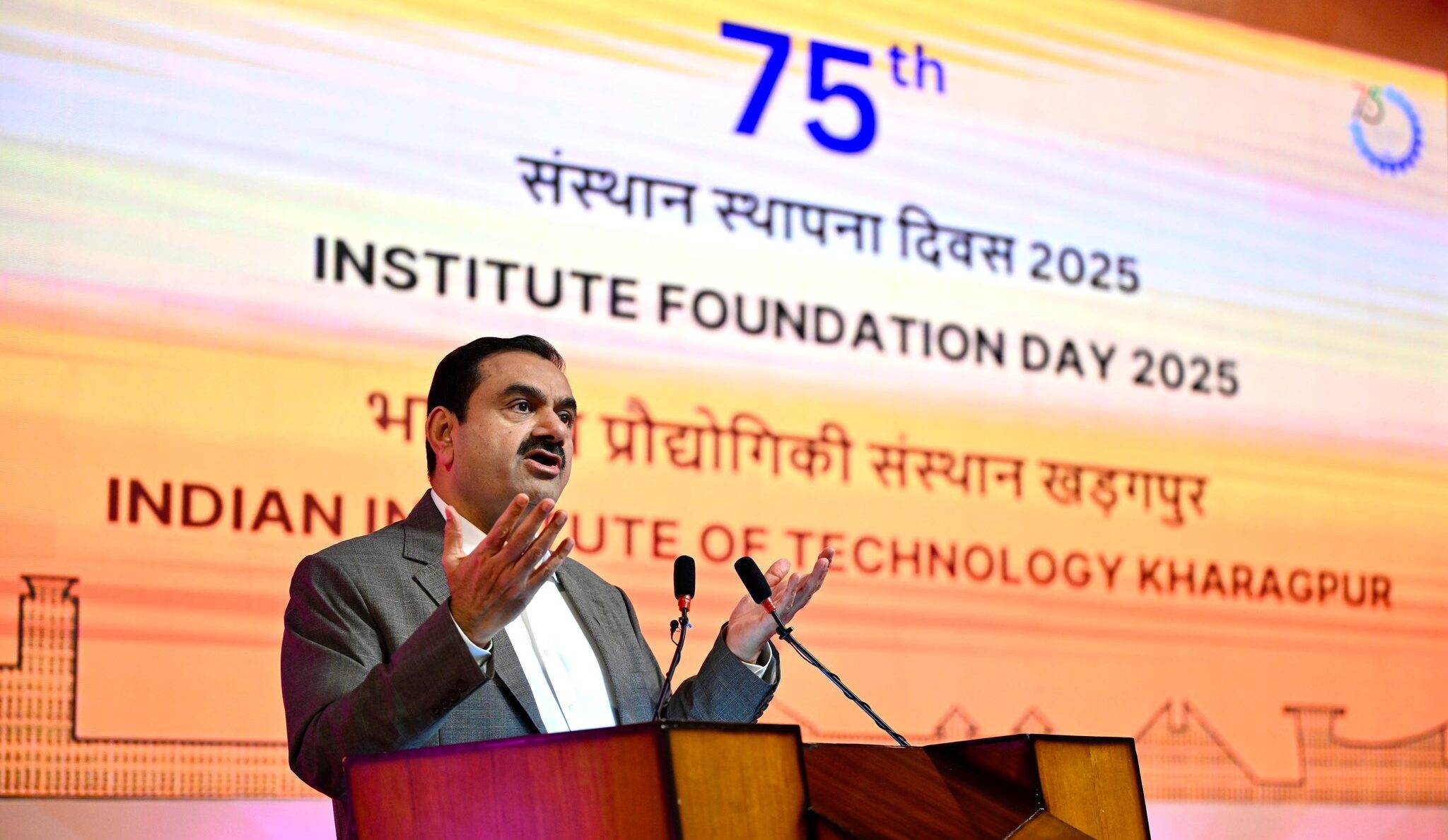Gautam Adani’s Warning – A Digital Economy at Risk
“Ninety percent of Indian semiconductors are imported. One disruption or sanction can freeze our digital economy,” industrialist Gautam Adani cautioned in an August 2025 address at IIT Kharagpur.
His stark warning underscored how chips, the tiny silicon engines of modern technology have become a strategic vulnerability for India. In the same breath, Adani likened India’s quest for technological self-reliance to a “second freedom struggle”, arguing that wars today are fought with algorithms and data rather than guns.

The message was clear: India’s overwhelming import dependence on semiconductors poses grave risks to its digital economy, national security, and future growth.
This reality check comes amid India’s spectacular digital rise. From smartphones and telecom networks to payment systems and advanced military hardware, semiconductors form the backbone of India’s $3 trillion economy.
Any interruption in chip supplies, whether due to geopolitical sanctions, trade wars, or global supply chain shocks could “freeze” critical sectors of the economy. Adani’s speech highlighted the urgency of fortifying India’s semiconductor ecosystem to safeguard its digital sovereignty and economic resilience.
A 90% Import Dependency: Scale of the Challenge
Adani’s 90% figure is backed by data: India currently imports roughly 90-95% of its semiconductors and electronic components. In the fiscal year 2023–24 alone, India’s semiconductor imports surged by 18.5%, reflecting voracious demand across smartphones, automobiles, data centers, and consumer electronics.
Major suppliers include countries like China, Taiwan, Singapore, and Malaysia. This near-total reliance on foreign chips has left India’s digital infrastructure highly vulnerable to external disruptions. As Adani noted, just as India imports 85% of its oil, exposing it to energy shocks, it also sources the vast majority of its “digital oil” from abroad.
This dependency stands in stark contrast to India’s growing consumption of semiconductors. India commands about 6.5% of global semiconductor demand as of 2025, a share set to rise with the spread of 5G, AI, electric vehicles and other technologies. By one estimate, India’s semiconductor end-use market is projected to double from around $54 billion in 2025 to $108 billion by 2030.

Yet, India’s own chip manufacturing capacity accounts for just 0.1% of the world’s wafer fabrication, effectively a rounding error. In other words, the nation of 1.4 billion barely makes any of the chips it consumes. This gulf between booming demand and negligible local supply encapsulates the strategic challenge: India’s digital ambitions remain built on silicon foundations largely laid abroad.
Nascent Domestic Manufacturing: Gearing Up for Change
For decades, India’s semiconductor production was confined to a few legacy facilities. The country missed earlier waves of fab investments, and until recently had no modern, high-volume chip fab in operation. That is now starting to change. New domestic manufacturing projects are finally taking root, backed by both government incentives and private sector initiatives, though most are still in early stages.
Projects sanctioned under India’s Semiconductor Mission span across multiple states, reflecting a nascent but growing chip manufacturing ecosystem (as of 2025).
In the last two years, India has launched a flurry of schemes to build an indigenous semiconductor ecosystem. The centerpiece is the India Semiconductor Mission (ISM), a government program announced in late 2021 and operationalized in 2022 with ₹76,000 crore (≈ $9 billion) in incentives.
This war chest supports everything from chip fabrication plants (fabs) to chip design companies, as well as assembly, testing, and packaging (ATMP) units that form the back-end of the supply chain. By covering the entire value chain, the aim is to not only make chips in India, but also to package and test them domestically, reducing reliance on imports at every stage.
These policies have begun to show results. In 2024, four semiconductor manufacturing units were approved under ISM, and another nine projects in related components secured nearly $900 million in investment commitments. Then in August 2025, the government green-lit four additional chip projects, bringing the total sanctioned under ISM to 10 projects with a combined investment of ₹1.6 trillion (≈ $18.2 billion).
This marks an unprecedented burst of activity for a sector that essentially started from scratch.
The new projects span geographies and specializations. For instance, Tata Electronics, in partnership with Taiwan’s PSMC, is setting up a ₹91,000 crore (≈ $10 billion) fabrication plant in Dholera, Gujarat, envisioned as India’s first modern 300mm silicon wafer fab, capable of processing 50,000 wafers per month.
U.S.-based Micron Technology is investing $2.5 billion in an ATMP facility in Gujarat for memory chip assembly and testing. A new HCL-Foxconn joint venture has plans for a semiconductor unit near the Delhi region, signifying Foxconn’s continued interest even after an earlier JV with Vedanta fell through.
In Odisha, a startup (SiCSem) backed by a UK firm is establishing India’s first semiconductor fab for silicon carbide (SiC) power chips, targeting the automotive and industrial markets. Another project in Odisha by 3D Glass Solutions will build an advanced packaging unit for next-gen chip packaging technologies.
Meanwhile, the venerable Indian firm CDIL is expanding its Mohali plant to make power semiconductor devices (like MOSFETs and IGBTs) using both silicon and SiC, crucial components for electronics and electric vehicles.
While none of these facilities are online yet, they signal India’s intent to plug key gaps in the supply chain. Notably, many focus on legacy-node chips, compound semiconductors, and packaging, areas where India can enter the market more feasibly, even if cutting-edge 3nm logic chips remain out of reach for now.
The cumulative planned capacity remains modest relative to India’s demand – for example, Tata’s upcoming fab (possibly on older process nodes) or the HCL-Foxconn fab will together meet only a slice of domestic consumption. But the strategic payoff is that India could produce its first homegrown chips within the next couple of years, a milestone that seemed elusive until recently.
Government and Industry: Investing in a Chip Future
Driving this momentum is a concerted government push, coupled with rising private sector enthusiasm. Beyond funding support, New Delhi has been aggressively courting global semiconductor players. Prime Minister Modi’s administration wooed firms at events like SEMICON India, a flagship conference organized annually since 2022 to showcase India’s chip ambitions.
Policy tweaks have also been made on the fly, for instance, when initial attempts faltered, the government increased fiscal support for new fabs to 50% of project cost and extended application deadlines. This flexibility helped bring back big-ticket proposals in 2023–24 after an earlier $19 billion Vedanta–Foxconn fab venture dissolved over technology tie-ups. As Rajeev Chandrasekhar, the then Minister of State for IT, noted, India is “finally utilizing the unique opportunity” in semiconductors after years of missed chances.
He pointed out that investment proposals worth $26 billion poured in within two years of launching the program, a sign of both industry interest and the government’s proactive approach.
Crucially, Indian conglomerates are now stepping up. The Tata Group has made semiconductors a key part of its strategy, beyond the Dholera fab, Tata is also establishing an OSAT (outsourced semiconductor assembly and test) plant in Assam with a ₹27,000 crore investment.
Other domestic majors like HCL, Reliance, and Vedanta have explored chip forays, seeing synergies with their electronics, telecom, or energy businesses. International partnerships are a common thread: almost every approved project has a foreign technology partner, be it Taiwan’s PSMC with Tata, France’s STMicro (via subsidiary) with Vedanta (in proposals), Japan’s Renesas with a consortium in Gujarat, or South Korea’s APACT with the new packaging unit in Andhra Pradesh. These alliances aim to transfer know-how and jump-start an ecosystem that currently lacks deep fabrication expertise.
India is also leveraging its strength in chip design talent to attract investments. The country already hosts roughly 20% of the world’s semiconductor design engineers, employed in R&D centers of companies like Intel, Qualcomm, and NVIDIA. By expanding design-linked incentive schemes, the government is nurturing local chip design startups and IP development, approving 23 domestic chip design projects in 2025 alone.
This complements the manufacturing push, as a robust design sector can feed into and benefit from local fabs and packaging units. The broader vision, as Minister Chandrasekhar puts it, is to move from import substitution to an export-led model where “almost everything, from chips to servers, will be manufactured in India, for India, and for the world”. It’s an ambitious goal, essentially to one day make India both a major chip producer and exporter, not merely self-sufficient but a global supplier.
Surging Demand vs. Domestic Capacity: Is It Enough?
Even with tens of billions of dollars of investments lined up, India’s semiconductor demand is poised to far outstrip local supply in the near term. The country’s appetite for chips is projected to grow at 15%+ CAGR, roughly double the global average, thanks to its digital transformation and burgeoning electronics manufacturing.
By 2030, annual semiconductor consumption could cross $100 billion. Meeting even a quarter of that demand with domestic chips would require multiple large fabs and factories operating at scale – an outcome still many years away.
The current slate of approved projects, if executed on schedule – will likely start production between 2025 and 2027. They focus largely on mature node technologies (e.g. 28nm to 65nm processes) and specialties like SiC power electronics, which are vital for cars, solar inverters, and 5G gear but not the advanced processors or memory that power cutting-edge smartphones and servers.
Thus, for advanced chips (7nm, 5nm and below), India will remain dependent on imports from leading chip nations (Taiwan, South Korea, US, etc.) for the foreseeable future. Domestic fabs will initially serve niche and domestic markets, such as automotive controllers, low-end processors, and defense electronics, helping trim the import bill gradually but not eliminating it.
Analysts note that bridging this gap is a long-term game. A Jefferies report (2025) emphasizes that while India’s semiconductor initiative has strong tailwinds (huge local talent pool, government support), it must overcome major structural hurdles to compete with established chipmaking hubs. Among the strategic gaps identified:
- Underdeveloped supply chain for materials and equipment: High-purity silicon wafers, specialty chemicals, gases, and ultra-pure water are all essential for chip fabs, but India currently lacks local sources for many of these. Companies will need to import critical inputs until domestic suppliers emerge, adding cost and complexity.
- Skilled manufacturing talent shortage: India’s engineering workforce is large but short on experts in semiconductor fabrication and process engineering. Building and running advanced fabs requires highly specialized skills that universities only recently started teaching. Initiatives are underway, new VLSI and microelectronics programs, training tie-ups with foreign players, but the talent pipeline will take time to mature.
- Infrastructure and cost challenges: Chip plants are capital-intensive, needing stable power, water, and cleanroom facilities. India’s industrial infrastructure is improving, yet power outages or water scarcity could be fatal for fabs if not managed. Competing countries like China, South Korea, and Taiwan have decades of head-start and government-subsidized ecosystems. India’s subsidies help, but ensuring ease of doing business from land acquisition to logistics, is critical to attract private investors for the long haul.
- Keeping pace with technology: The semiconductor industry relentlessly pushes toward smaller, more powerful chips. India as a late entrant will initially focus on older technologies, which carry lower risk, but it must avoid becoming a “tech backwater.” Continuous R&D and potential future partnerships for advanced nodes will be needed so that India’s fabs don’t become obsolete as global tech moves forward. This is where planned institutions like the Bharat Semiconductor Research Centre (announced by the government for next-generation research) will play a role.
In short, India’s production ramp-up will be gradual, and for the medium term the country will still rely on imports for many critical chips. However, every percentage point shift from 95% import-dependence to, say, 70-80% over the next decade could have massive economic and strategic impact. Local chip output means less foreign exchange spent on imports, more high-tech jobs, and crucially, a buffer against global supply shocks.
Strategic Imperatives: Security, Resilience, and Digital Sovereignty
The push for a self-reliant semiconductor ecosystem in India is not merely about economics or industrial policy, it is deeply intertwined with national security and strategic autonomy. Modern warfare and intelligence rely on secure chips, and as Adani observed, “many of our critical military systems are imported, bringing our national security to the will and supply chains of other nations”.
This dependency raises the specter of a supplier country withholding components in a crisis or embedding vulnerabilities in hardware. Developing indigenous chip-making capability, even if initially at older tech nodes is seen as vital for defense self-reliance. For instance, having a local source for military-grade microprocessors or radars’ chips can ensure the armed forces aren’t crippled by sanctions or embargoes in times of conflict.
Likewise, economic resilience is at stake. The COVID-era global chip shortage in 2021–22 severely affected Indian industries like automobile manufacturing, leading to production cuts due to lack of semiconductors. A domestic chip supply, even a limited one, provides a hedge against such external disruptions.
Moreover, as India aspires to be a global electronics manufacturing hub (with programs like “Make in India”), availability of locally made chips can strengthen the supply chain and reduce lead times for manufacturers. Government planners even eye an export opportunity: if India can make chips at scale, it could serve other markets and cushion itself against import volatility.
Policymakers project that with sustained effort, India might leapfrog from near-zero chip exports today to possibly $80 billion in annual exports by 2030 – an ambitious target that underscores the desire not just to substitute imports, but to become a net exporter in the long run.
Finally, the concept of digital sovereignty looms large. In an era where data is the new gold, controlling the hardware that processes and stores that data is a form of sovereignty. Indian leaders often cite the fact that when India’s data flows across borders, it becomes “raw material for foreign algorithms”, enriching others’ AI models and economies. By the same token, if India lacks the capability to produce advanced chips, it remains beholden to foreign companies (and governments) for the brainpower of its digital infrastructure.
Cultivating a domestic semiconductor base is therefore seen as akin to a nation securing its own food supply or energy reserves, only for the digital age. It is about having the freedom to innovate and build in India without fear of technological denial regimes or coercion. As Adani framed it, “the freedom we must now fight for [is] the freedom of self-reliance” in technology.
Towards a Self-Reliant Semiconductor Ecosystem
India’s journey to reduce its 90% semiconductor import dependence is just beginning, but the trajectory is set. The coming years will test the country’s resolve as multi-billion dollar projects move from MoUs and groundbreaking ceremonies to actual chip production on the ground.
Success will hinge on consistent policy support, skill development, and perseverance in the face of inevitable setbacks. The early signs are encouraging, from large conglomerates to startups, a broad coalition is coalescing to build India’s semiconductor ecosystem nearly from scratch. As one expert noted, India now has “clarity from the top” – a strategic vision backed by the highest levels of government, which is drawing investors and partners worldwide.
Yet, realism is warranted. Self-sufficiency in semiconductors will not be easy or quick. It will likely take a decade or more of sustained effort before Made-in-India chips substantially displace imports. In the interim, India must also maintain good trade relations and “friend-shoring” partnerships (such as with the U.S., Japan, and EU) to secure critical chip supplies while its domestic industry scales up. The India-U.S. semiconductor cooperation under the “Chip 4” and Indo-U.S. “trust” initiatives is one such strategic alignment aimed at building “trusted and resilient supply chains” for chips.
From a finance and economic standpoint, the opportunity is enormous. A thriving semiconductor sector could add tens of billions to GDP, create hundreds of thousands of high-tech jobs, and reduce the electronics trade deficit. It can also catalyze related industries, from materials and chemicals to equipment maintenance and research services – truly embedding India in the global tech supply chain.
As of 2025, India’s share in global chip manufacturing is tiny, but the momentum of multibillion-dollar investments and policy impetus suggests this may not remain the case for long.
In the words of Ex. Minister Chandrasekhar, “after years of neglect, India is finally well-equipped with talent, design expertise, and manufacturing capabilities” to seize the semiconductor moment.
The next few years will reveal how much of this promise translates into silicon reality. For now, Adani’s dire warning echoes as both a rallying cry and a reminder: India’s digital destiny hinges on its ability to shed the dependence on 90% imported chips and build an ecosystem that can power the India Techade on its own silicon. The race for atma nirbharta (self-reliance) in semiconductors has begun in earnest and its outcome will define India’s economic and strategic future in the decades to come.
Also Read: Indichip plans semiconductor facility in Andhra Pradesh























